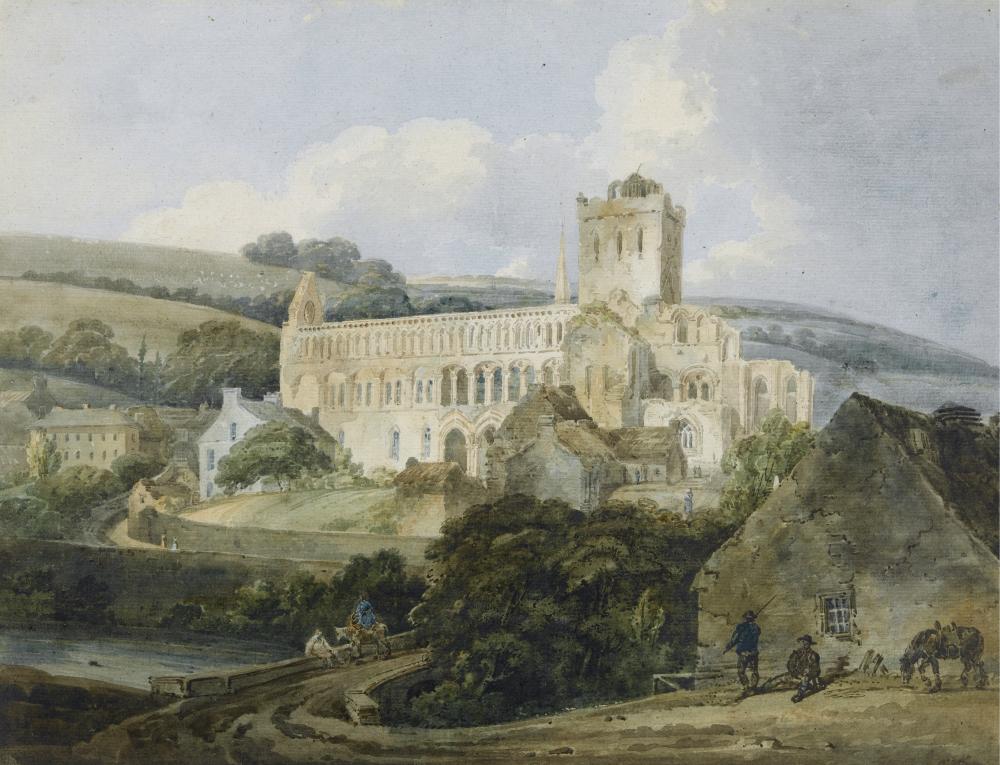J.M.W. TURNER R.A.
(1775-1851)
John Dryden's Monument, Westminster Abbey
Engraved: J.Horsburgh for Scott's Miscellaneous Prose, Vol.I, 1834-6
Provenance
H.A.J. Munro of Novar
Bought by McLean
Private Collection, United Kingdom
Literature
W.G. Rawlinson, The Engraved Work of J.M.W. Turner, Vol.II, 1913, pp.201,285
A.Wilton, The Life and Work of J.M.W. Turner, 1979, no.1094 (as untraced)
L.Herrmann, Turner Prints: The Engraved Work of J.M.W Turner, 1990, p.268
J.Piggot, Turner's Vignettes,1993, pp.56,59,99 ( as untraced)
This recently rediscovered watercolour vignette is from the series of forty illustrations Turner made to illustrate Sir Walter Scotts; Miscellaneous Prose, issued in twenty-eight volumes between 1834 and 1836. He had previously illustrated Scott's Poetical Works, a commission from the Edinburgh publisher Robert Cadell (1788-1849), who had observed the enormous success of Murray's illustrated edition of Byron (see The Gate of Theseus) and had decided- despite Scott's personal dislike of Turner - that his participation would guarantee large sales. Turner accepted the commission gladly, surprising the publisher that he charged only 25 guineas for each design, and they struck up a warm professional relationship, as revealed in Cadell's diaries, account books and letters. Even before the publication of the Poetical Works, Turner began to plan the illustrations for the Miscellaneous Prose in the summer of 1832, shortly before Scott's death in September. Besides Scott's Life of Napoleon, the most important item in the Prose Works, which ran to a total of nine volumes and for which Turner created one of his most important groups of illustrations, the rest of the series consisted of five volumes of history, contributions to various periodicals, the Provincial Antiquities, the original 1919 edition of which Turner had illustrated, and several biographies. The very first volume of the Miscellaneous Prose, under the editorship of Scott's son-in-law J.G. Lockhart, was his Life of Dryden, for which Turner made this watercolour c.1833. Two further vignettes commemorated other authors especially admired by Scott: Shakespeare and Smollett.
Turner's preparatory studies for this vignette are in the Mouth of the Thames sketchbook, now in Tate Britain (T B CCLXXVIII-5, 6 and 7), one of which is very close in compostition tot he present work, showing Dryden's monument amidst the towering columns of Westminster Abbey. Turner's earliest training had been as an architectural draughtsman, giving him unparalleled assurance in handling subjects such as this, in which he evoked the monumentality of the Abey despite the diminutive size imposed by the vignette format.
John Dryden (1631-1700), Poet Laureate, playwright, satirist and translator, was one of the great literary figures of his age. The sheer volume of his literary output impressed Scott, himself no slouch, and his 18 volume edition of Dryden's Works, 1808 of which Vol.I was the biography, remained standard until the mid-twentieth century.
The engraver of this vignette was John Horsburgh (1791-1869), who had first engraved Turner's work in 1824; he lived and worked in Edinburgh.


